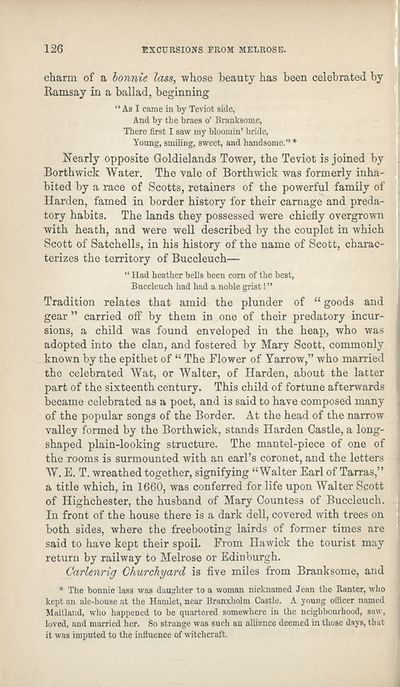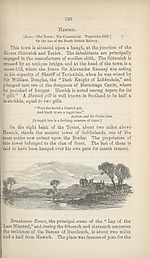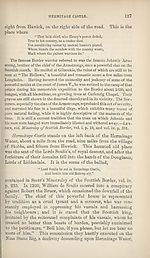Download files
Complete book:
Individual page:
Thumbnail gallery: Grid view | List view

126
EXCURSIONS FROM MELROSE.
charm of a bonnie lass, whose beauty has been celebrated by
Ramsay in a ballad, beginning
“ As I came in by Teviot side,
And by tbe braes o’ Branksome,
There first I saw my bloomin’ bride,
Young, smiling, sweet, and handsome.” *
Nearly opposite Goldielands Tower, the Teviot is joined by
Borthwick Water. The vale of Borthwick was formerly inha¬
bited by a race of Scotts, retainers of the powerful family of
Harden, famed in border history for their carnage and preda¬
tory habits. The lands they possessed were chiefly overgrown
with heath, and were well described by the couplet in which
Scott of Satchells, in his history of the name of Scott, charac¬
terizes the territory of Buccleuch—
“ Had heather bells been com of the best,
Buccleuch had had a noble grist! ”
Tradition relates that amid the plunder of “ goods and
gear ” carried off by them in one of their predatory incur¬
sions, a child was found enveloped in the heap, who was
adopted into the clan, and fostered by Mary Scott, commonly
known by the epithet of “ The Flower of Yarrow,” who married
the celebrated Wat, or Walter, of Harden, about the latter
part of the sixteenth century. This child of fortune afterwards
became celebrated as a poet, and is said to have composed many
of the popular songs of the Border. At the head of the narrow
valley formed by the Borthwick, stands Harden Castle, a long¬
shaped plain-looking structure. The mantel-piece of one of I
the rooms is surmounted with an earl’s coronet, and the letters I
W. E. T. wreathed together, signifying “Walter Earl of Tarras,’’
a title which, in 1660, was conferred for life upon Walter Scott
of Highchester, the husband of Mary Countess of Buccleuch.
In front of the house there is a dark dell, covered with trees on j
both sides, where the freebooting lairds of former times are t
said to have kept their spoil. From Hawick the tourist may
return by railway to Melrose or Edinburgh.
Carlenrig Churchyard is five miles from Branksome, and j
* The bonnie lass was daughter to a woman nicknamed Jean the Ranter, who J
kept an ale-house at the Hamlet, near Branxholm Castle. A young officer named j
Maitland, who happened to be quartered somewhere in the neighbourhood, saw, j
loved, and married her. So strange was such an alliance deemed in those days, that i
it was imputed to the influence of witchcraft.
EXCURSIONS FROM MELROSE.
charm of a bonnie lass, whose beauty has been celebrated by
Ramsay in a ballad, beginning
“ As I came in by Teviot side,
And by tbe braes o’ Branksome,
There first I saw my bloomin’ bride,
Young, smiling, sweet, and handsome.” *
Nearly opposite Goldielands Tower, the Teviot is joined by
Borthwick Water. The vale of Borthwick was formerly inha¬
bited by a race of Scotts, retainers of the powerful family of
Harden, famed in border history for their carnage and preda¬
tory habits. The lands they possessed were chiefly overgrown
with heath, and were well described by the couplet in which
Scott of Satchells, in his history of the name of Scott, charac¬
terizes the territory of Buccleuch—
“ Had heather bells been com of the best,
Buccleuch had had a noble grist! ”
Tradition relates that amid the plunder of “ goods and
gear ” carried off by them in one of their predatory incur¬
sions, a child was found enveloped in the heap, who was
adopted into the clan, and fostered by Mary Scott, commonly
known by the epithet of “ The Flower of Yarrow,” who married
the celebrated Wat, or Walter, of Harden, about the latter
part of the sixteenth century. This child of fortune afterwards
became celebrated as a poet, and is said to have composed many
of the popular songs of the Border. At the head of the narrow
valley formed by the Borthwick, stands Harden Castle, a long¬
shaped plain-looking structure. The mantel-piece of one of I
the rooms is surmounted with an earl’s coronet, and the letters I
W. E. T. wreathed together, signifying “Walter Earl of Tarras,’’
a title which, in 1660, was conferred for life upon Walter Scott
of Highchester, the husband of Mary Countess of Buccleuch.
In front of the house there is a dark dell, covered with trees on j
both sides, where the freebooting lairds of former times are t
said to have kept their spoil. From Hawick the tourist may
return by railway to Melrose or Edinburgh.
Carlenrig Churchyard is five miles from Branksome, and j
* The bonnie lass was daughter to a woman nicknamed Jean the Ranter, who J
kept an ale-house at the Hamlet, near Branxholm Castle. A young officer named j
Maitland, who happened to be quartered somewhere in the neighbourhood, saw, j
loved, and married her. So strange was such an alliance deemed in those days, that i
it was imputed to the influence of witchcraft.
Set display mode to:
![]() Universal Viewer |
Universal Viewer | ![]() Mirador |
Large image | Transcription
Mirador |
Large image | Transcription
| Antiquarian books of Scotland > Scotland/Scots > Black's picturesque tourist of Scotland > (186) |
|---|
| Permanent URL | https://digital.nls.uk/130030422 |
|---|
| Description | Thousands of printed books from the Antiquarian Books of Scotland collection which dates from 1641 to the 1980s. The collection consists of 14,800 books which were published in Scotland or have a Scottish connection, e.g. through the author, printer or owner. Subjects covered include sport, education, diseases, adventure, occupations, Jacobites, politics and religion. Among the 29 languages represented are English, Gaelic, Italian, French, Russian and Swedish. |
|---|

